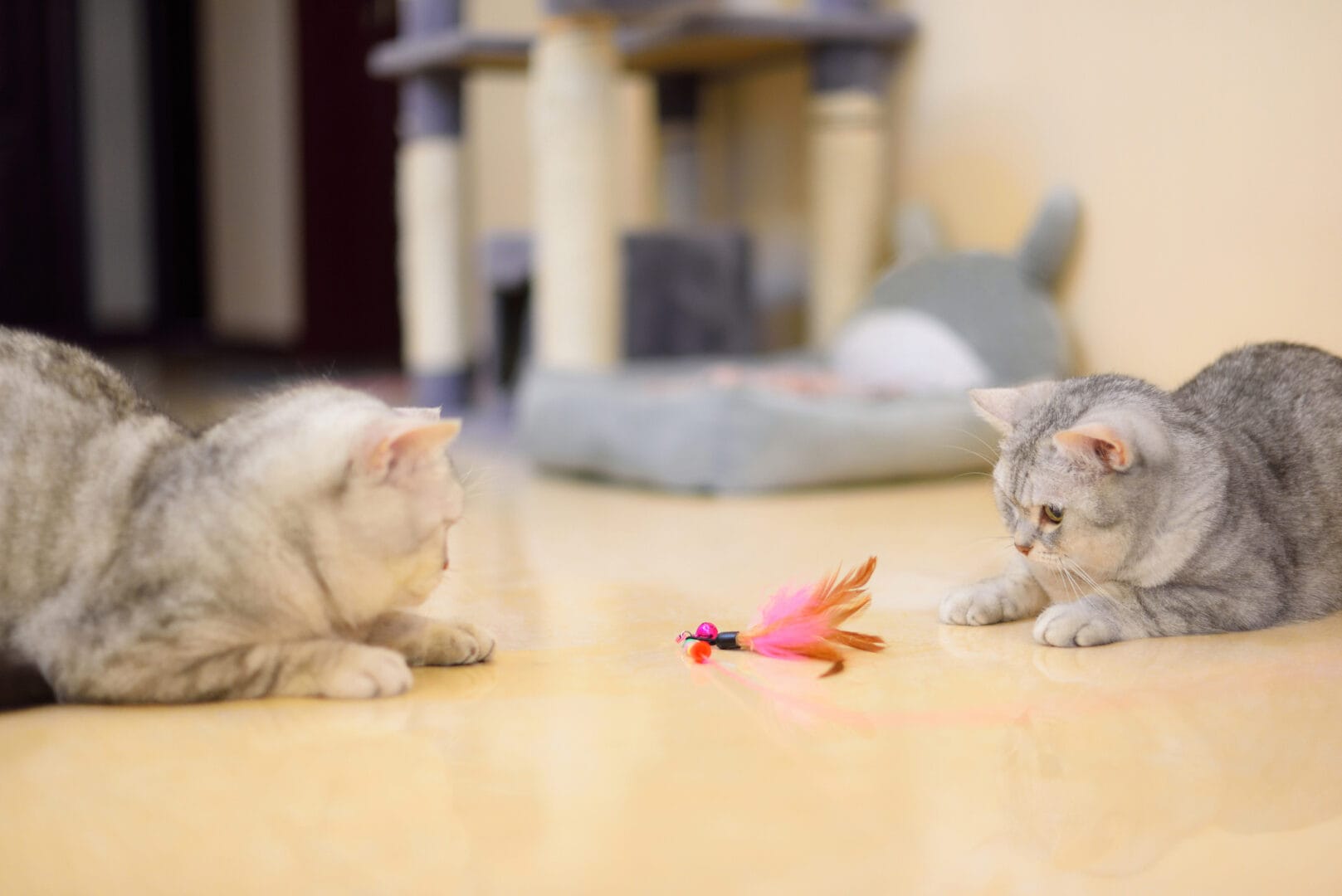When my American shorthair Linus first met his new cat brother Theodore, things went far better than expected. They were introduced slowly, and within less than a week, they were snuggly nap partners. Fast forward a few years, however, and their dynamic had not-so-suddenly changed. There was hissing and swatting, chasing and hiding – and I had no idea why.
“I find that many inappropriate feline behaviors stem from lack of perceived resources in the home,” says Dr. Christa Kahuda, the owner and medical director at Charleston Harbor Veterinarians in Charleston, South Carolina. But in her 10+ years of experience as a veterinarian, Kahuda has found that humans tend not to fully understand cats’ needs, which makes calming tension between them feel next to impossible.
Here, experts shed light on why feline aggression is common in multi-cat households, plus offer simple ways to better understand and meet their needs so you can stop cat conflicts at home once and for all.
How to tell the difference between cat fighting and playing
There are two types of signs that cats are fighting: open and silent, according to experts at the Ohio State University (OSU) College of Veterinary Medicine, Kahuda’s go-to source when it comes to understanding conflicts in cats. Open signs of fighting include:
- Stalking.
- Hissing.
- Swatting.
- Wrestling.
- Biting.
These types of signs are easy to spot, but can also be mistaken for rough play.
“Real play between cats will involve minimal to no hissing or growling,” says Dr. Kelly St. Denis, a board certified veterinarian in feline medicine and former president of the American Association of Feline Practitioners. “The cats will take breaks between bouts of wrestling and chasing and will equally initiate these activities. If there is growling, hissing or one cat initiates the activity more, then this is more likely to be termed fighting.”
“Real play between cats will involve minimal to no hissing or growling.”
— Dr. Kelly St. Denis, board certified veterinarian in feline medicine
Silent signs of fighting, however, are much more subtle and easy for caregivers to miss. They can be spotted in both the assertive as well as the threatened cat. Here’s what to look out for, according to OSU experts:
An assertive cat:
- Never backs away from other cat.
- Denies other cats access to resources.
- Stares at other cat.
- Rubs cheeks, head, chin, and tail on people, doorways and furniture at cat height.
- Lowers its head while elevating its hindquarters as it approaches other cat.
- Emits a low growl when seeing other cat.
A threatened cat:
- Spends large amounts of time hiding or away from the family.
- Avoids eye contact with other cat.
- Yields resources to other cat.
- Crouches then may flee when approached.
- Does not vocalize.
Why cats “bully”
“It’s important to think about the competition for resources and related anxiety between cats in multi-cat households, rather than labeling either cat a ‘bully,’” says St. Denis. Admittedly, the easiest way to talk about my own cat’s behavior years ago was “bullying.” But now, I’ll be the first to say that it wasn’t accurate — nor did it help because it made me overlook resources he was lacking.
Conflict can crop up over access to obvious resources, like food, water and litter boxes. But perches, sunny areas, safe places where the cat can watch its environment, or even attention from people, can also be perceived as resources for cats, according to the experts at OSU. What’s more, there doesn’t need to be a real threat to a cat getting to any of these resources, rather just the perception that they no longer have control can trigger conflict.
It’s important also to keep in mind that certain acute situations can also breed “bullying” behavior. Kahuda recommends contacting your vet for advice when it comes to introducing a new cat into an environment where a cat is already present so you can pave the way for more positive interactions.
“The goal should be for cats to coexist without conflict in the home,” says Kahuda. “They may not always become ‘friends’ – but if they do, consider it a bonus!”
Steps to stop aggressive behavior between cats
“There is no quick fix when it comes to repairing relationships,” says renowned cat behavior and wellness expert Jackson Galaxy. “That’s true for humans and cats. But in the absence of couples therapy as an option for cats, we have to do it by demonstrating and providing.” You want both a threatened cat and an assertive cat to feel there is no competition for resources, explains Galaxy.
“There is no quick fix when it comes to repairing relationships.”
— Jackson Galaxy, cat behavior and wellness expert
To level the playing field and reduce tension between cats, here’s what to do.
Step 1: Check off the essentials
Providing individual essential resources in your home – food, water, litter box – in locations where cats can use them without being seen by other cats is a good first step, according to experts at OSU. This allows cats to avoid each other if they choose without being deprived.
Make sure cats have been neutered and their nails are trimmed as short as possible, suggests OSU.
Step 2: Create more resources
Your instinct may be to separate fighting cats since their resources may be in different rooms. But adding new resources to shared territories, like additional perches, beds and kitty condos, will be more effective at decreasing competition in the long-run. Galaxy calls this method for calming cat tension environmental enrichment.
“Separate resources aren’t going to cut it,” he says. “If you think about places that are important to cats, it’s not just the litter box, food or preferred beds. It’s also about your important places where your scent is the strongest: the bed, the couch. Cats are going to want to be a part of that important social structure in your home.”
When assessing a room in your house, he recommends looking at it like your cat who considers their territory from the floor to the ceiling. High shelves make for great places to lounge and having multiple is key. This will let an aggressive cat know he doesn’t need to “own” all these spaces, but rather choose where he wants to be.
“Cats are very adept at site-sharing,” Galaxy says. “This is how they exist in colonies [in the wild]. It’s about making sure there are enough resources to go around.”
Step 3: Make time to play every day, the right way
Playtime is not as frivolous as it may sound, especially in a multi-cat household. “Basically what you’re doing is helping cats relate to their confident predator side as opposed to their insecure prey side,” says Marci L. Koski, a certified feline behavior and training consultant at Feline Behavior Solutions in Washington who holds her doctorate in Fishery and Wildlife Biology. “Essentially, play sessions are substitutes for hunting sessions. Play provides an outlet for those instinctual predator behaviors, builds confidence and relieves stress.”
At the very least, Koski recommends a daily 15-minute play session for each cat and emphasizes the importance of doing this one-on-one. “That can help even the shyest cat come out of his shell,” she says, since they will not fear they are being preyed on while they hunt.
When it comes to toys, Koski likes long wand toys that allow owners to move the lure at the end to resemble real prey in the wild. These also get out the most energy so there is less that can be redirected toward another cat in the house.
When it comes to providing cats the proper resources, Galaxy reiterates the importance of play and keeping to a schedule. “You have to assume it’s needed,” he says, pointing out that an interactive toy that comes out at the same time every day is just as important for a cat as a collar and a leash are for a dog.
Step 4: Re-introduce cats that need to separate
While separating cats is not a long-term solution, it is an important short-term solution if they are at risk of causing physical harm to one another. Hair on the ground, screaming or the presence of blood, pee or poop indicate a cat is in danger, explains Galaxy.
“If this happens every time these cats see each other, we separate,” he says. “But now we have to reintroduce these cats as if they’ve never met before. If the victim has learned nothing other than he’s prey, then the aggressor will always act as the predator.”
His preferred method for reintroducing fighting cats is with food. To do this, stop all snacking between meals and only feed your cats on either side of a shared door so they can’t see each other. “They relearn that everytime I smell this cat, I get food,” says Galaxy. “I can do this without attacking.” This is a long, detailed process, but you can see how it plays out in a YouTube video featuring Galaxy:
Step 5: Know when to seek help
“Properly managed from the start, we hopefully never need pharmaceutical management,” says St. Denis. “However, if inter-cat issues arise, it is important to seek veterinary care and advice, as the problem could be medical for one or both cats.”
In my situation, I learned Linus was not a “bully” at all, but dealing with pain from bladder stones and likely taking his discomfort out on others. Getting him the proper medical attention was ultimately an important part calming his aggression.
If you’ve tried all the steps above and ruled out or addressed a medical issue, Galaxy recommends seeking a certified cat behavioral specialist. St. Denis also recommends Cat Friendly Homes as a great resource for pet owners. They cover topics including what cats need to feel secure, why cats are territorial, aggression and more so you can become more knowledgeable about your cat’s instincts and behavior triggers.
While aggressive cat behavior may seem mystifying, cats are actually wired so closely to their ancestors that the reasons for conflict are clearer than pet owners may think:
“This is not truly a bullying situation, but a situation in which there are insufficient, well-distributed resources resulting in the need to protect them,” says St. Denis. “If the resources are provided in multiples and distributed throughout the household, this will allow the cats to form their own individual territories within the household, reducing inter-cat tension significantly.”





